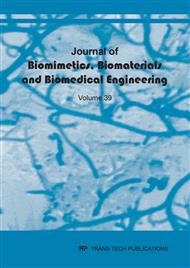[1]
S .Chandra, S.S. Raut, A. Jana, R.W. Biederman, M. Doyle, S.C. Muluk , E.A. Finol, Fluid-Structure Interaction Modeling Of Abdominal Aortic Aneurysms: The Impact Of Patient Specific Inflow Conditions And Fluid/Solid Coupling, Journal of Biomechanical Engineering. 135 (2013).
DOI: 10.1115/1.4024275
Google Scholar
[2]
K. M. Tse, P. Chiu, H. P. Lee, P.Ho, Investigation of hemodynamics in the development of dissecting aneurysm within patient-specific dissecting aneurismal aortas using computational fluid dynamics (CFD) simulations, Journal of Biomechanics. 44 (2011).
DOI: 10.1016/j.jbiomech.2010.12.014
Google Scholar
[3]
H. Bengtsson, D .Bergqvist, Ruptured abdominal aortic aneurysm: a population- based study, journal of vascular surgery. 18 (1993) 74–80.
DOI: 10.1067/mva.1993.42107
Google Scholar
[4]
A.C. Knowles, J.D. Kneeshaw, Aortic arch surgery. In: Mackay JH, Arrowsmith JE (Eds). Core Topics in Cardiac Anaesthesia, Greenwich Medical Media, London (2004).
Google Scholar
[5]
F.Gao, A. Qiao, T. Matsuzawa, Numerical Simulation in Aortic Arch Aneurysm, Etiology, Pathogenesis and Pathophysiology of Aortic Aneurysms and Aneurysm Rupture. 12 (2011) 208-222.
DOI: 10.5772/18566
Google Scholar
[6]
M. Simão, J. M. Ferreira, A.C. Tomás, J. Fragata, H. M. Ramos, Aorta Ascending Aneurysm Analysis Using CFD models towards Possible Anomalies, fluids. 2, 31 (2017) 1-15.
DOI: 10.3390/fluids2020031
Google Scholar
[7]
O .R. Bonow, D. Mann, D. Zipes, P. Libby, Braunwald's Heart Disease: In A Textbook of Cardiovascular Medicine, Elsevier Health Sciences: Amsterdam, The Netherlands 9 (2011).
Google Scholar
[8]
E. K. Shang, D. P. Nathan, S.R. Sprinkle, Impact of Wall Thickness and Saccular Geometry on the Computational Wall Stress of Descending Thoracic Aortic Aneurysms, Circulation. 128 (2013) 157-162.
DOI: 10.1161/circulationaha.112.000200
Google Scholar
[9]
N. Demanget, S. Avril, P. Badel, L. Orgéas, C. Geindreau, J. N. Albertini, J. P. Favre, Computational comparison of the bending behavior of aortic stent-grafts, Journal of the Mechanical Behavior of Biomedical Materials. 5 (2012) 272-282.
DOI: 10.1016/j.jmbbm.2011.09.006
Google Scholar
[10]
R.M. Greenhalgh, L.C. Brown, D. Epstein, G.P.S. Kwong, J.T. Powell, M.J. Sculpher, S.G. Thompson, Comparison of endovascular aneurysm repair with open repair in patients with abdominal aortic aneurysm (EVAR trial 1), 30-day operative mortality results. randomised controlled trial, Lancet. 364 (2004).
DOI: 10.1016/s0140-6736(04)16979-1
Google Scholar
[11]
J.N. Albertini, J.A. Macierewicz, S.W. Yusuf, P.W. Wenham, B.R. Hopkinson, Pathophysiology of proximal perigraft endoleak following endovascular repair of abdominal aortic aneurysms: a study using a flow model, Eur J Vasc Endovasc Surg. 22 (2001).
DOI: 10.1053/ejvs.2001.1385
Google Scholar
[12]
R.A. Baum, S.W. Stavropoulos, R.M. Fairman, J.P. Carpenter, Endoleaks after endovascular repair of abdominal aortic aneurysms, J Vasc Interv Radiol. 14 (2003) 1111–1117.
DOI: 10.1097/01.rvi.0000085773.71254.86
Google Scholar
[13]
R.B. Rutherford, W. C. Krupski, Current status of open versus endovascular stent-graft repair of abdominal aortic aneurysm, Journal of Vascular Surgery. 39 (2004) 1129–1139.
DOI: 10.1016/j.jvs.2004.02.027
Google Scholar
[14]
S. Lau, stent pour limiter la dilatation progressive de l'aorte ascendante dans les cas de bicuspidie de la valve aortique : preuve de concept, dissertation, chap,2 (2014) 31.
Google Scholar
[15]
C.A. Figueroa, C.A. Taylor, V. Yeh, A.J. Chiou, M.L. Gorrepati, C.K. Zarins, Preliminary 3D computational analysis of the relationship between aortic displacement force and direction of endograft movement, Journal of vascular surgery. 51 (2010).
DOI: 10.1016/j.jvs.2010.01.058
Google Scholar
[16]
E. Georgakarakos, A. Xenakis, G.S. Georgiadis, C. Argyriou, G. a Antoniou, N. Schoretsanitis, M.K. Lazarides, The hemodynamic impact of misalignment of fenestrated endografts: a computational study, European journal of vascular and endovascular surgery. 47 (2014).
DOI: 10.1016/j.ejvs.2013.09.029
Google Scholar
[17]
B.A. Howell, T. Kim, A. Cheer, H. Dwyer, D. Saloner, T.A.M. Chuter, Computational fluid dynamics within bifurcated abdominal aortic stent-grafts, Journal of Endovascular Therapy. 14 (2007) 138– 143.
DOI: 10.1583/1545-1550(2007)14[138:cfdwba]2.0.co;2
Google Scholar
[18]
R. Layman, S. Missoum, J. V. Geest, Simulation and probabilistic failure prediction of grafts for aortic aneurysm, Engineering Computations. 27 (2010) 84–105.
DOI: 10.1108/02644401011008531
Google Scholar
[19]
Z. Li, C. Kleinstreuer, Analysis of biomechanical factors affecting stent-graft migration in an abdominal aortic aneurysm model, Journal of Biomechanics. 39 (2006) 2264–2273.
DOI: 10.1016/j.jbiomech.2005.07.010
Google Scholar
[20]
D.S. Molony, E.G. Kavanagh, P. Madhavan, M.T. Walsh, T.M. A. Mc Gloughlin, computational study of the magnitude and direction of migration forces in patient-specific abdominal aortic aneurysm stent-grafts, European journal of vascular and endovascular surgery. 40 (2010).
DOI: 10.1016/j.ejvs.2010.06.001
Google Scholar
[21]
A. Prasad, N. Xiao, X.Y. Gong, C.K. Zarins, C.A. Figueroa, A computational framework for investigating the positional stability of aortic endografts, Biomechanics and modeling in mechanobiology. 12 (2013) 869–87.
DOI: 10.1007/s10237-012-0450-3
Google Scholar
[22]
T. J. HUGHES, A study of the one-dimensional theory of arterial pulse propagation. Structural Engineering Laboratory, University of California, Berkeley, California (1974).
Google Scholar
[23]
C. A. Taylor, M. T. Draney, Experimental and computational methods in cardiovascular fluid mechanics, Annual Review Fluid Mechanics. 36 (2004) 197–231.
Google Scholar
[24]
J. Lantz, J. Renner, M. Karlsson, Wall shear stress in a subject specific human aorta, influence of fluid-structure interaction, International Journal of Applied Mechanics. 3 (2011) 759–778.
DOI: 10.1142/s1758825111001226
Google Scholar
[25]
C. Duanduan, M.E. Matthias, T.K. Hendrik, B. David , B. Dittmar , H. Rod , V. Yiannis , A patient-specific study of type-B aortic dissection: evaluation of true-false lumen blood exchange. BioMedical Engineering OnLine. (2013)12-65.
DOI: 10.1186/1475-925x-12-65
Google Scholar


